It helps to have a good editor, says Kadir, especially when he's not writing the text of a picture book. It's good to have support as he works in solitude. He likes the fresh eye of an editor to look at his sketches or his manuscript.
He's telling us about sending a manuscript to his agent, something that he'd been working on for months. He asked his agent (Steven Malk), "does this stink?" Steve, he said, didn't tell him is was bad, but, in his tactful way, told him he needed to keep working on it, and that there were gems in his work. He like to have the encouragement to help him get from B+ work to A+ work.
POSTED BY ALICE POPE
Viewing: Blog Posts Tagged with: Kadir Nelson, Most Recent at Top [Help]
Results 26 - 36 of 36
Blog: The Official SCBWI 10th Annual New York Conference Blog (Login to Add to MyJacketFlap)
JacketFlap tags: picture books, Kadir Nelson, Add a tag
Blog: The Official SCBWI 10th Annual New York Conference Blog (Login to Add to MyJacketFlap)
JacketFlap tags: LA09, picture books, craft, Kadir Nelson, Eve Bunting, Arthur Levine, Melinda Long, Lee Wind, Add a tag
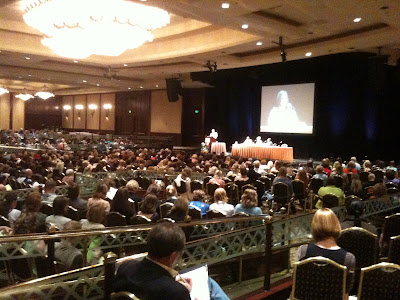 1000 people listen raptly to Arthur A. Levine, Eve Bunting, Kadir Nelson, and Melinda Long!
1000 people listen raptly to Arthur A. Levine, Eve Bunting, Kadir Nelson, and Melinda Long!
Blog: The Official SCBWI 10th Annual New York Conference Blog (Login to Add to MyJacketFlap)
JacketFlap tags: picture books, Kadir Nelson, Add a tag
With any book that I do, the most important thing for me is to be relaxed, says Kadir. "I spend a lot of time stalling."
POSTED BY ALICE POPE
Blog: The Official SCBWI 10th Annual New York Conference Blog (Login to Add to MyJacketFlap)
JacketFlap tags: picture books, Kadir Nelson, Moses, Add a tag
Arthur asks the panel to talk about their own books: which ones are extraordinary?
Kadir Nelson on Moses: He related to and connected to Harriet Tubman by thinking of his grandmother. She inspired him to do extraordinary work.
POSTED BY ALICE POPE
Blog: The Official SCBWI 10th Annual New York Conference Blog (Login to Add to MyJacketFlap)
JacketFlap tags: picture books, Kadir Nelson, Add a tag
Arthur Levine is hosting this panel and asks: What makes a picture book extraordinary?
Kadir Nelson: "The art has to be excellent, the story has to be excellent, and work well together. The art and pictures have to speak to a personal truth and a universal truth."
POSTED BY ALICE POPE
Blog: Biblio File (Login to Add to MyJacketFlap)
JacketFlap tags: history, Nonfiction, Juvenile, nonfiction monday, Kadir Nelson, Scott Reynolds Nelson, Add a tag
It's Nonfiction Monday! And I'm talking about two more books that were on the Cybils short-list for MG/YA nonfiction, one of which I really liked, and one of which I really hated.
This is a beautifully illustrated book about Negro League baseball. It won the Coretta Scott King honors for artwork and writing and it won the Sibert.
I'm still fuming.
I mean, it wasn't my favorite for King illustrator--it wasn't even my favorite Kadir Nelson book this year (I really liked his work in Abe's Honest Words) but I can understand why it won. I have much greater issues with the writing. I think it's an interesting story and kids will respond to the everyman first person narration, even though I find it fundamentally flawed. Not overjoyed with the writing winning an award, but also not surprised.
I am, however, extremely upset that it won the Sibert. There is NO WAY this book should be held up as a good example of nonfiction for kids.
Let's take another look at those illustrations. Many (possibly all) are based on real photographs. Yes, Nelson is an amazing painter and he breathed new life into those photos but... using paintings instead of photographs when they're obviously available? It makes the book less accurate, because instead of looking at real evidence, we're looking at an artistic interpretation of it.
And oh, the writing. History should NEVER be in first person if the author wasn't involved in the history. I know who Kadir Nelson is, and even I found myself asking at one point if he played for the Negro Leagues. Also, in taking the everyman approach, it makes the text confusing. When discussing how rough the players played, Nelson often says "they" or "them" but he's still in first person, so it sounds like these rough players weren't Negro league players--it sets up a horribly confusing us/them dichotomy.
Now yes, this first person narration makes the book vastly more appealing to kids, it's fundamentally not true and should not be held up as an example to strive for. How would you cite that in a paper? Can you imagine quoting something like this in a research project? How would you explain that yes, your quotation is in first person, but the person talking doesn't really exist? Will kids even realize that Nelson wasn't a baseball player? I had to go back and say "wait, what?" several times, and I consider myself to be a stronger and more experienced reader than most children, especially when it comes to history. And before you say that kids don't need to cite things and write research papers, yes, yes they do. And maybe not everything is a valid source, but if are going to give it an award for what children's nonfiction should be, then it should be a valid source. I don't lower my standards of nonfiction when it comes to stuff written for kids.
Nelson could have written a great and readable book in third person, but no. He chose something that makes his book less accurate, less true, and confusing to understand.
Also, there was no shout-out to the women who played in the leagues. No mention of them whatsoever.
Overall, yes, kids will really like this book. Yes, the pictures are beautiful. BUT! This is NOT what nonfiction for children should be. I'm dismayed that the Sibert committee thinks it is.
Ain't Nothing but a Man: My Quest to Find the Real John Henry Scott Reynolds Nelson
Now this is how you do history in first person. Scott Reynolds Nelson (not to be confused with Kadir Nelson, whom I discussed above) is a historian and was studying the man behind the myth presented in songs about John Henry. This can be told in first person because it's about Nelson's own story, his research process as he tracks down the real story.
Nelson shows how historians get ideas and clues from a lot of different areas and objects--not just letters and records, but postcard pictures, song lyrics, and maps. The reader learns a lot about the research process, but also reconstruction, prison labor, and how the railroads were built.
The design is super kid-friendly. My only complaint is a personal one. Nelson needed to look at some records at the archives that were closed. While he does explain all the reasons why records might be closed, his frustration paints the archivists kind of like bad guys. I understand not getting the records you need and how frustrating that is, but, as a trained archivist, I have a little more sympathy for the record keepers than Nelson does. :)
After reading the book, I had to listen to this on repeat for about an hour.
Round up is over at Miss Rumphius Effect.
Blog: Lori Calabrese Writes! (Login to Add to MyJacketFlap)
JacketFlap tags: We Are the Ship, Kadir Nelson, Add a tag
 The big announcements were made yesterday as ALA announced the literary award winners. I was glued to the feed on my computer! I was very excited that JudyAnn Grant's Chicken Said, "Cluck!" (My First I Can Read)
The big announcements were made yesterday as ALA announced the literary award winners. I was glued to the feed on my computer! I was very excited that JudyAnn Grant's Chicken Said, "Cluck!" (My First I Can Read) was a Geisel Honor Book! Be sure to read my interview with Judy from last year- she really deserves it! For a great roundup of all the winners, head on over to The Horn Book.
Another author I was excited to see win was Kadir Nelson who walked away with the Coretta Scott King Award (Author Award and Illustrator Honor Book!). We Are the Ship is also nominated for the Cybils' Middle Grade/ YA Nonfiction Category. I reviewed We Are the Ship last year, but I wanted to talk about it again, since I'm celebrating the Cybils here this week! We Are the Ship: The Story of Negro League Baseball
We Are the Ship: The Story of Negro League Baseball
Author/ Illustrator: Kadir Nelson.
Publisher: Jump at the Sun/ Hyperion, January 2008
Reading Level: Ages 9 and up
Illustrator and first time author, Kadir Nelson brings us this magnificent book on the story of Negro League Baseball. As long as there has been baseball in America, there have been African-American ballplayers. Rube Foster was the founder of the Negro National League and said of his men, "We are the ship: all else the sea." On February 20, 1920, Rube Foster called together the owners of African-American baseball teams and the Negro National League was formed. This book is jam packed with information and facts about the men who played the sport, the hardships they faced, including the low pay and the dangers of playing in the South, and also, the great plays, crazy rules, and the stars that broke out. I have a new respect for the players in the Negro League after reading this book because of things like, "...throwing at a batter was common. The pitcher would knock you down just to mess with your head. Look up at the umpire, and he'd just say, "Get up and play ball, son." That's why the batting helmet was invented." The book climaxes with Jackie Robinson making it into Major League Baseball, thus the end of the Negro League, but Nelson's story will leave a lasting impression with you.
Hank Aaron writes the foreword and says he's grateful for Kadir's fresh approach. We should ALL be grateful for Kadir's fresh approach, and his desire to share the story of a group of men that changed the sport of baseball and made it what it is today. After reading this again for the Cybils, I fell even more in love with it. The voice that it is written in is truly unique and makes you feel as though you're sitting alongside a group of old players reminiscing about the glory days. This book is unlike any other and each illustration makes you feel as though you're in the heart of the action. Kadir has been drawing since the age of three, and painting since the age of ten and that's evident in his amazing illustrations.
Visit Kadir Nelson's website. It's worth a visit to see his amazing gallery and if you're interested, Nelson offers limited edition prints from this book. Visit the NPR website for an interesting interview with Kadir Nelson. He states that this book took him nearly eight years to complete and it offers an excerpt from the book.
Blog: Lori Calabrese Writes! (Login to Add to MyJacketFlap)
JacketFlap tags: Ellen Levine, NonFiction Monday, Kadir Nelson, Henry's Freedom Box, Add a tag
 Henry's Freedom Box (Caldecott Honor Book)
Henry's Freedom Box (Caldecott Honor Book)
Author: Ellen Levine
Illustrator: Kadir Nelson
Publisher: Scholastic Press; January, 2007
Reading Level: Ages 4-8
This Caldecott Honor Book is the daring true story of former Virginia slave Henry "Box" Brown. Born a slave, Henry and his siblings worked in the "big house" for his master -- who, on his deathbed, gave Henry to his son. During the years he worked for the son in his tobacco warehouse, Henry met and married another slave, with whom he had three children. One day while Henry was working, his family was sold in the slave market and they disappeared down the road. After weeks of despair, Henry had an idea while moving a crate. He would mail himself to freedom "to a place where there are no slaves!" He travels by horse-drawn cart, steamboat, and train before his box is delivered to the Philadelphia address of an abolitionist doctor friend. Award winning illustrator Kadir Nelson's realistic paintings bring Henry's sad experiences to life and reveals the lengths a man would go to for freedom. This book will appeal to the young reader and encourage older readers to learn more about the life of courageous Henry "Box" Brown on their own. Use this beautifully illustrated picture book to help children understand the underground railroad, and the harsh realities of slavery.
Would you have yourself crated up and shipped from slavery to liberty?
Hop over to Anastasia Suen's picture book of the day blog for the Nonfiction Monday roundup!
Blog: World of Words (Login to Add to MyJacketFlap)
JacketFlap tags: kadir nelson, news, author interviews, kadir nelson, Add a tag
I recently reviewed a new book by Kadir Nelson, We Are The Ship. Here is a recent interview with him about the book.
Blog: Through the Studio Door (Login to Add to MyJacketFlap)
JacketFlap tags: favorite books, Kadir Nelson, Kadir Nelson, Add a tag
 I gotta have this book! Every so often a book comes along that just grabs you from the get go. For me this is one of those books. I love the tittle. I love the story behind the book. I'm a big fan of Kadir Nelson. The previews of the illustrations are amazing. I want to see more. I want to read the story. I want to savor this book.
I gotta have this book! Every so often a book comes along that just grabs you from the get go. For me this is one of those books. I love the tittle. I love the story behind the book. I'm a big fan of Kadir Nelson. The previews of the illustrations are amazing. I want to see more. I want to read the story. I want to savor this book.
To find out more just follow these links:
Interview with Publishers Weekly.
We are the Ship Website.
YouTube Video.
I wonder if it's something about the whole story of baseball that I can't resist. I noticed a few of my all-time favorite books are on the same topic. I listed them here a while back while talking about inspiration.
Blog: The Excelsior File (Login to Add to MyJacketFlap)
JacketFlap tags: movies, memoir, middle grade, essay, viking, pippi, lindgren, wild child, Add a tag
 by Astrid Lindgren
by Astrid Lindgren
Translated by Florence Lamborn
published in Sweden in 1944
Viking Press edition 1950
Pippi scared me when I was young. It had nothing to do with the books at all, and certainly nothing to do with some sort of threat to my prepubescent masculinity of this scrawny little Amazon, but it had everything to do with the 1960's movie based on the book.
Funny how memory is. I can see these images as part of my childhood vividly like they happened a few years ago, but I have to remind my kids that I first encountered Pippi back in the days before there were DVD's, before videos, and in this case even before my family owned a color television. In that blue-green cathode haze Pippi held a strange power that made me watch with my face half turned away in fear. I knew girls like Pippi, girls that could womp a baseball better than I ever would and wouldn't think twice about jumping down an open manhole cover, but they didn't scare me like this.
Because Pippi was the first movie I ever saw dubbed into English. How and why did they talk like that? Their mouths and the sounds they made didn't sync up and worse; The way they were dubbed, stilted and forced like bad community theatre thespians trying to read Shakespeare into whimsy, had me feeling there was an invisible presence in the room that had turned down the sound and was making up the dialog for all the characters as they went along. And because of all this I never read Pippi Longstocking until I was a full-grown adult and felt I could handle it subject without the fear of those early memories rushing to accost me.
How and why did they talk like that? Their mouths and the sounds they made didn't sync up and worse; The way they were dubbed, stilted and forced like bad community theatre thespians trying to read Shakespeare into whimsy, had me feeling there was an invisible presence in the room that had turned down the sound and was making up the dialog for all the characters as they went along. And because of all this I never read Pippi Longstocking until I was a full-grown adult and felt I could handle it subject without the fear of those early memories rushing to accost me.
How nice it was to finally get Pippi in her correct form, a spunky and precocious 10 year old with a pet monkey and a horse that lives on the front porch. She lives by her own rules and with total abandon, and can foil crooks just as handily as Homer Price. That adults are dolts and can be outwitted by a wild child like Pippi is cake for a young reader . That Pippi actually doesn't even care about any adult besides her father is the icing.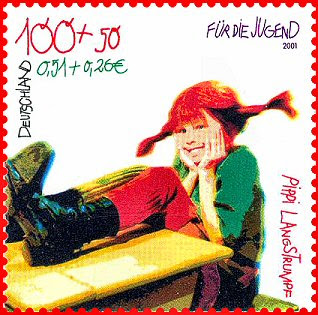 Lindgren -- in a fashion that must be a genre unto itself by now -- originally wrote these tales for her own children. Writing to please children may seem obvious but many who try tend to fail because they impose their adult logic and adult world onto the proceedings. Logic alone is enough to kill a good story. Not that children don't long for and crave logic, because they do, but it's the logic they create that's important. When you think about what we do as developing humans, how we take raw data and information and learn to craft connecting ideas, thoughts into images into ideas into logic, the whole of it more impressive than anything we claim as adults. As adults we manipulate the hardware and the software of the brain to make sense of our world; As children we build the hardware and software from scratch and call it the world.
Lindgren -- in a fashion that must be a genre unto itself by now -- originally wrote these tales for her own children. Writing to please children may seem obvious but many who try tend to fail because they impose their adult logic and adult world onto the proceedings. Logic alone is enough to kill a good story. Not that children don't long for and crave logic, because they do, but it's the logic they create that's important. When you think about what we do as developing humans, how we take raw data and information and learn to craft connecting ideas, thoughts into images into ideas into logic, the whole of it more impressive than anything we claim as adults. As adults we manipulate the hardware and the software of the brain to make sense of our world; As children we build the hardware and software from scratch and call it the world.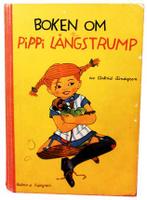 At the core of the Pippiverse are two innocents who serve as our grounding, Tommy and Anika. They provide the necessary balance that allows the Pippi books to endure because they counter the desire to "be good" with the twined desire to explore without rules. When challenged, even to the brink of hysterical danger, everything works out in the end because deep down Pippi has total unspoken faith that it will. I don't think it would take much to apply the lessons of Pippi into some warm-and-comfy self-help impulse item sitting on the counter at your local chain bookstore. Here's hoping no one thinks this is a good idea.
At the core of the Pippiverse are two innocents who serve as our grounding, Tommy and Anika. They provide the necessary balance that allows the Pippi books to endure because they counter the desire to "be good" with the twined desire to explore without rules. When challenged, even to the brink of hysterical danger, everything works out in the end because deep down Pippi has total unspoken faith that it will. I don't think it would take much to apply the lessons of Pippi into some warm-and-comfy self-help impulse item sitting on the counter at your local chain bookstore. Here's hoping no one thinks this is a good idea.
Many books for children feature troubled families and it's an odd comfort we find in seeing that others might have it worse than we readers do. I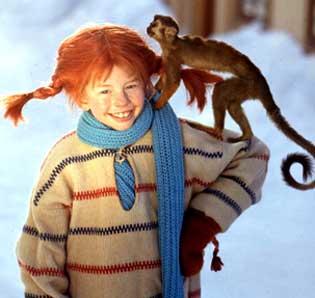 know I'm not the only person who felt like his family was severely dysfunctional while viewing other equally dysfunctional families as more "normal" than my own. That sense of "other" aside, what tripped me up while reading was that I didn't believe Pippi when she said her father, The Captain, would come home one day. I committed the adult sin of doubting a child. No matter how fictitious, I'm sure that as a child myself I would have taken Pippi at her word or at least given her the benefit of the doubt where my adult mind tried to force the story to conform to my own adult sense of what was "right". What a joy -- an honor, really -- to be bested by Pippi like all the other stubborn fools she's encountered.
know I'm not the only person who felt like his family was severely dysfunctional while viewing other equally dysfunctional families as more "normal" than my own. That sense of "other" aside, what tripped me up while reading was that I didn't believe Pippi when she said her father, The Captain, would come home one day. I committed the adult sin of doubting a child. No matter how fictitious, I'm sure that as a child myself I would have taken Pippi at her word or at least given her the benefit of the doubt where my adult mind tried to force the story to conform to my own adult sense of what was "right". What a joy -- an honor, really -- to be bested by Pippi like all the other stubborn fools she's encountered.



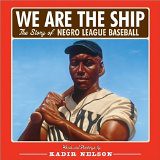
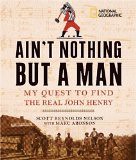
Interesting perspective.
I absolutely loved the book -- for adults. It made a great old-dude-who-still-thinks-he-can-play-ball Christmas gift. I found it a beautiful book - but I love Kadir Nelson's artwork, and I thought the voice was very good. First person is a questionable choice for nonfiction, perhaps, but it's interesting it brought out such a strong reaction.
You know, had it not won the Sibert, I think I would have been OK with it. It's not my cup of tea, but it wouldn't have gotten such a strong reaction out of me. The fact that the Sibert (and other awards, I mean, it was short listed for the Cybil) are holding it up as an example of excellent nonfiction for kids is what makes me so upset.
It's a perfectly fine book that a lot of people will enjoy. It's NOT a perfectly fine work of nonfiction.
Thanks for the review of Ain't Nothing But a Man. I've loved the John Henry story since I was a little kid, long, long ago. I'll have to read this. My oldest girl will like this, too.